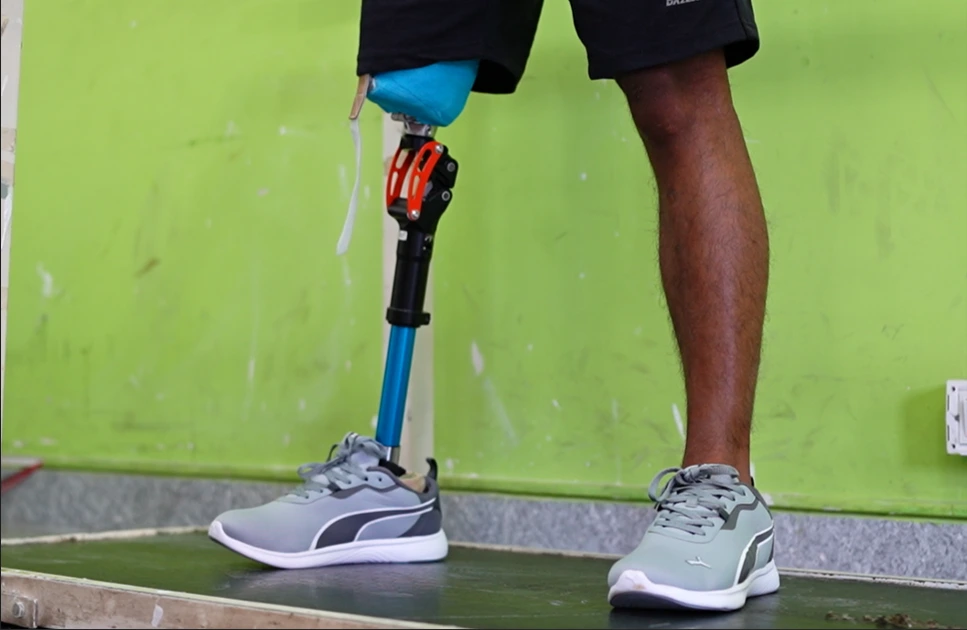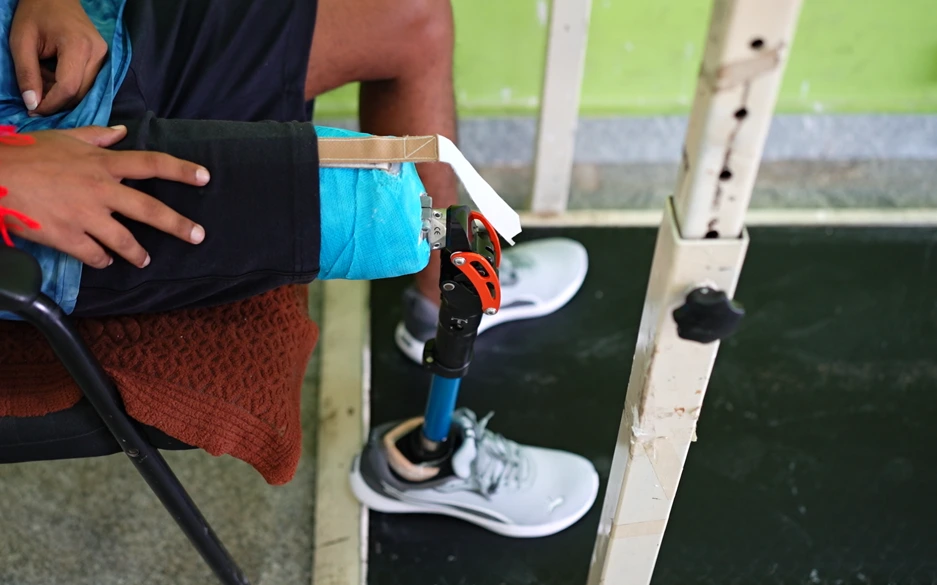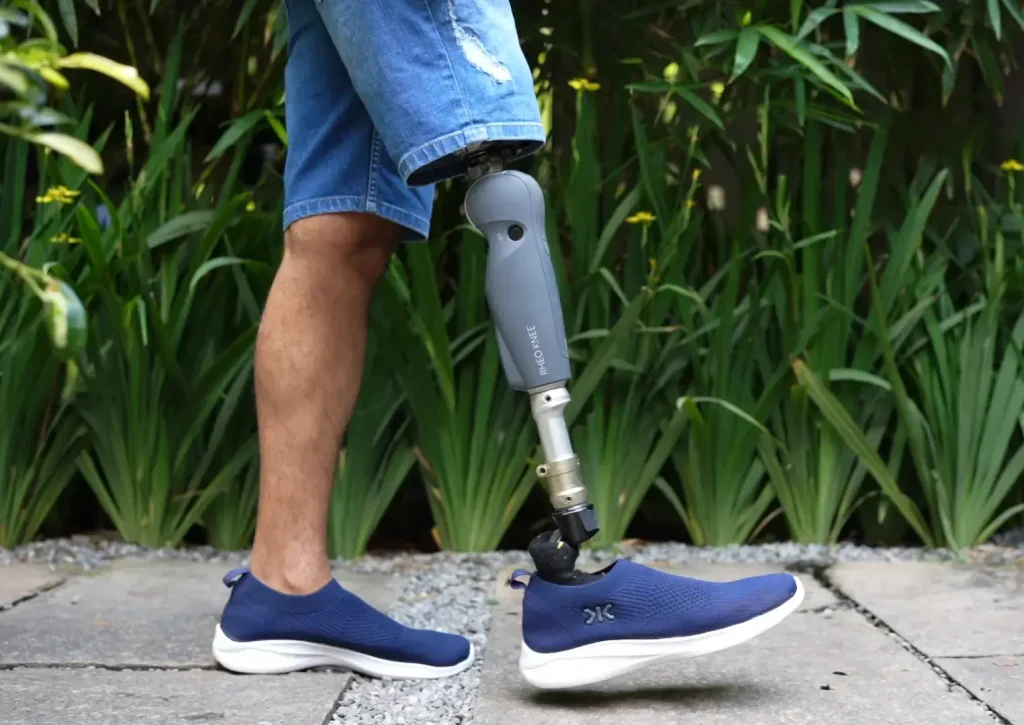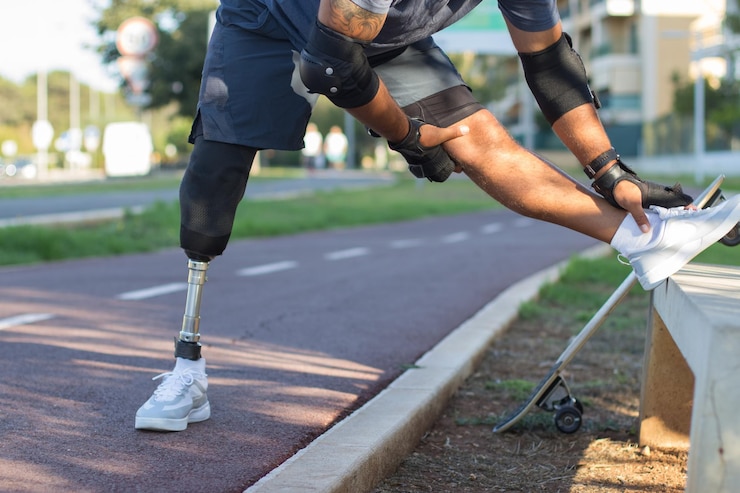
Losing a leg above the knee is equal to losing your independence and mobility. But that can be changed with today’s advanced prosthetic technology; individuals can use an above-knee prosthesis to live an active life. An above-knee prosthesis is a moderate mobility grade tool, suitable for moderate activity, including day-to-day tasks and outdoor walking, enabling you to perform routine activities and pursue your passions.
In this guide, we’ll explore everything you need to know, from how a prosthesis works to recovery, walking tips, and costs in India.
What Is An Above Knee Prosthesis
An above-knee prosthesis is an artificial leg that helps individuals whose leg above the knee has been amputated regain mobility. It restores the leg’s function and appearance.
This artificial leg has a socket that goes around your remaining limb, a knee system that lets you bend your leg, a way to keep it in place, a shank, and a foot-ankle system. Each prosthesis is custom-made based on your health, what you do, and what you need. This ensures that the prosthesis fits your life just right.
Key Components of an Above Knee Prosthesis
- Socket: A custom-moulded interface that connects your residual limb to the prosthetic leg.
- Suspension System: Keeps the prosthesis in place using suction, vacuum, or mechanical locks.
- Knee Joint: Allows bending and straightening. Comes in various designs from basic to computerised.
- Pylon (Shank): The structural connector, typically made from carbon fibre or aluminium.
- Prosthetic Foot: Mimics foot movement and offers balance and shock absorption.
- Cosmetic Cover: Foam or silicone layer that resembles a natural limb.
What is an Above Knee Amputation
A transfemoral amputation, popularly known as an above-knee amputation, is a surgical procedure that removes the leg above the knee joint if necessary.
Why Is an Above Knee Amputation Performed
- Trauma: It may create conditions when salvaging the limb is impossible due to accidents or other injuries.
- Peripheral vascular disease (PVD) / Diabetes leads to poor blood circulation, tissue death and wounds that do not heal.
- Infection: When infections create life-threatening issues
- Cancer: When cancer develops in the bone or soft tissues.
An above-knee amputation is necessary to create a healthy and well-shaped stump suitable for fitting a prosthetic limb.
The Transfemoral/ Above Knee Prosthesis Components
1. Prosthetic Foot
A prosthetic foot is an artificially constructed foot which restores mobility and function for amputees. It mimics the natural movement of a foot, absorbing shock and returning energy for a seamless walk. Prosthetic feet are customised to suit activity levels.
Prosthetic Foot Types
- SACH (Solid Ankle Cushioned Heel) Foot: Basic features, durable, and cost-effective.
- Flexible Keel Foot: Enhances flexibility and is better for uneven terrain.
- Single-Axis Foot: Allows up-and-down movement at the ankle for stability.
- Multi-Axis Foot: Enables motion in multiple directions, allowing for adaptation to uneven surfaces.
- Dynamic Response Foot: This foot stores and releases energy for active users, enabling a more natural stride.
- Hydraulic Ankle-Foot: It offers a natural motion at the ankle, improves shock absorption, and uses fluid.
- Microprocessor Foot: It has sensors and computer chips for real-time adjustments, advanced mobility and stability.
2. Prosthetic Knee Joint
It can take the place and function of a natural knee and allow bending and straightening. Different prosthetic knee joint types are;
Mechanical Knees
- Single-Axis: These have a hinge mechanism and a basic movement.
- Polycentric (Multi-Axis): Multiple rotation points for better natural movement and stability.
- Manual Locking: The system is locked and has to be released manually. It provides maximum stability.
- Weight-Activated Stance Control: It gets locked when weight is placed and prevents buckling.
- Pneumatic/Hydraulic: It has air or fluid to control the swing phase, allowing varied walking speeds.
Microprocessor-Controlled Knees (MPKs)
These smart knees use sensors to detect movement and terrain and make real-time adjustments for fluid movement, balance, and fall prevention
3. Pylon (Shank)
It is a strong, structural connector linking the prosthetic knee joint to the prosthetic foot or socket to the foot for below-knee amputations. This lightweight shank uses durable carbon fibre or aluminium materials.
- The endoskeletal system: It has an internal support structure (the pylon) with a cosmetic foam cover.
- Exoskeletal: This rigid, weight-bearing outer shell offers structural support.
How Do the Prosthetic Parts Work Together
- The socket is precisely moulded to your residual limb and fits snugly. It attaches the prosthetic to your body.
- The suspension system helps the prosthesis stay attached to the limb and may include features such as sleeve suction, distal locking, or vacuum suspension.
Why Above Knee Prosthesis Alignment Matters
Proper alignment is necessary for comfort, smooth movement, and long-term benefits. Every part needs to work in harmony.
- It lets you walk naturally and efficiently.
- Stops pain and relieves pressure.
- Decreases the energy needed to walk.
- Saves your hips and back from strain.
Principles of Alignment
- Socket Fit: The socket should fit comfortably, ensuring alignment and even pressure distribution.
- Components: The knee joint, the pylon, and the prosthetic foot should be placed to support your body and allow fluid movement.
- Body’s Biomechanics: Correct alignment lets the prosthesis seamlessly integrate with your body’s natural mechanics.
What Happens with Poor Alignment
- Discomfort
- Uneven gait
- Energy expenditure
- Skin breakdown or joint pain
The Role of a Prosthetist
A prosthetist checks and evaluates your specific needs to design the socket. They also pick out parts and line them up to ensure your prosthesis works well, feels good, and lets you move.
How to Put On Your Above Knee Prosthesis Confidently

The process of putting on the above-knee prosthesis is:
1. Prepare Your Limb
- Cleaning: Regularly clean your prosthetic socket and residual limb to prevent skin issues.
- Socks & Liners: Use the correct prosthetic socks or liners to manage the limb’s volume changes, cushion it, and ensure a comfortable fit.
2. Donning Techniques
The Pulling Method
- Using a donning sock.
- Pull the sock to cover your residual limb and through the socket bottom.
- Pull your limb down into the socket using the sock.
- Once your limb is aligned, pull the sock out through the bottom.
Suspension Sleeve
- If your prosthesis uses a silicone suspension sleeve, roll it up your thigh, over the top edge of the socket, and onto your thigh to create a seal.
Suction Suspension
- You have to use a one-way valve to push down. You will notice your limb creating a whoosh sound as the limb creates a vacuum seal in the socket.
3. Troubleshooting:
- Common Issues: If you experience discomfort, it may be due to incorrect limb alignment. You can pull it in again or adjust your socks or liners.
- Contact Your Prosthetist: If you see signs of skin breakdown or feel loose or too tight.
Key Tips
- Be Patient.
- Regular practice.
- Follow Proper Technique
How to Walk with an Above-Knee Prosthetic Effectively
Practising walking with an above-knee prosthesis is crucial, but you’ll regain incredible mobility with the proper techniques and support.
Effective Walking Fundamentals:
- Weight Shifting: When you shift your weight onto your prosthetic side, the knee mechanism activates, preparing the leg for bearing your full weight.
- Balance & Core Strength: Balancing exercises and strengthening your core help you to be more stable.
- Cadence and Stride Length: For a natural and energy-efficient gait, smooth rhythm and even stride should be your aim.
Understanding the Walking Phases
- Stance Phase: Placing the prosthetic foot on the ground with your weight helps stabilise the knee joint.
- Swing Phase: Moving the prosthetic leg forward through the air helps control the knee, allowing the limb to swing smoothly and clear the ground.
Walking
- Begin Safely: Using crutches or a walker for support and parallel bars.
- Stepping Challenges: Winning over minor obstacles and increasing coordination.
- Surfaces: Walking on various surfaces, such as carpet, pavement, and grass.
The Role of Physical Therapy
A trained physical therapist will teach:
- Proper Gait.
- How to strengthen muscles.
- Improving balance and coordination.
- Refining your walking pattern.
Prosthetic Leg Above Knee Cost in India
- Basic (Mechanical): ₹25,000 – ₹50,000
- Mid-Range (Hydraulic): ₹50,000 – ₹1,50,000
- Advanced (Microprocessor): ₹1,50,000 – ₹15,00,000
What Factors Drive the Prosthetic Leg Above Knee Cost
Prosthetic leg types
- Basic types have a low mobility grade suitable for less activity and indoor walking. They are non-electronic, have simple designs and features, and are affordable.
- Mechanical types offer advanced features, providing better movement at a mid-range cost.
- Bionic and robotic types have a high activity grade for active users who perform rigorous activities and sports. They include AI, sensors, and microprocessors for natural movement and stability. These features add to the cost, making them the most expensive.
Material Used
- Common Metals and plastics: These are cheaper, heavier, and not durable.
- Carbon Fibre & Titanium: Long-lasting, robust and lightweight.
- Silicone and advanced Polymers provide a natural appearance but are expensive.
Customisation & Fitting
- A customised fit offers comfort and function. It needs skilled technicians and precise measurements.
- Custom designs and specific movement needs add to the cost.
Technology & Features
- Microprocessors, fluid-powered systems, and smart sensors that use AI boost stability, make changes on the go, and cut down on energy use
- Advanced technology for improving the quality of life costs more.
Insurance & Assistance
- Coverage under private insurance or Ayushman Bharat (PMJAY) may apply
Conclusion
Losing your leg above the knee can significantly impact your independence. But it doesn’t have to remain that way. It is possible to live an active life once more with a suitable above-knee prosthesis and proper support.
This journey to regain mobility will test your patience and perseverance, and will require the right team to guide you. But at KARE Prosthetics & Orthotics, we’ve seen people like you take that first step and go on to live independent lives. So, you can.
We’re ready to support your journey to regain independence, with expert care, custom-fitted solutions, and genuine encouragement. Contact KARE today.





